In today’s world, the idea of anyone recommending or advocating the carriage of a revolver as a primary defensive handgun is usually met with scorn and ridicule by self-appointed firearms “experts.”
Editor’s Note: We’re happy to welcome Darryl Bolke back to our pages, with his thoughts on where revolvers fit into landscape of defensive handguns. Enjoy!
The modern, compact and service size semiautomatic service pistols are preferred by most people, because they’re incredibly reliable and size efficient. This size efficiency is why I usually carry one every day. With the higher capacity guns, I can stay in a fight longer, with less manipulations required to keep the gun running.
Yet, for all the benefits that the modern semiautomatic pistol brings to the table, an equally good case can be made for today’s modern defensive revolver. The modern defensive revolver offers benefits that may appeal to some people, and be a better fit for their needs than a semiauto.
Advantages
My favorite aspect of the modern defensive revolver is that they are incredibly easy to operate, administratively. I can get a very good idea of its condition simply by looking at it, and can easily confirm its condition by opening the cylinder. It’s easy to manipulate the revolver and check its condition in a safe manner.
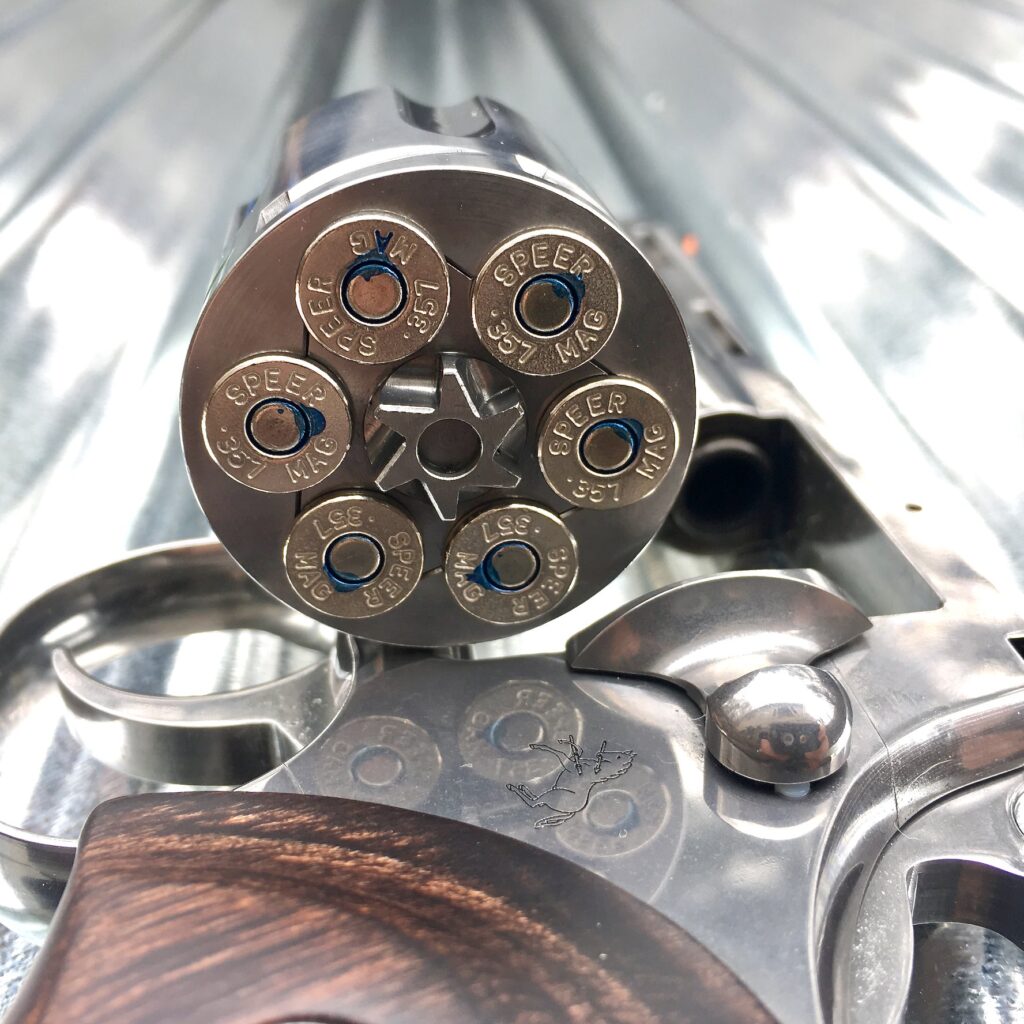
This is not the case with the modern, striker-fired semiautomatic pistol. The basic design of a semiauto pistol makes it more difficult to verify its condition, and more prone to safety violations in the hands of the poorly trained or disciplined shooter. Many folks are carrying and using guns like this who cannot perform a loaded chamber verification, clear the weapon, or conduct a simple status check safely. They would definitely benefit from the simplicity of a revolver’s manual of arms.
Another benefit of the revolver is that it’s easier to use as a training tool. I have a revolver nearby most of the time for my dry practice work. Before conducting dry practice, I remove the ammunition on board, which is often held in a moon clip, and replace it with either a moon clip or a speedloader full of snap caps. I use these inert training tools to provide an extra layer of protection against leaving a loose round in the gun. Anytime we have an extra fail safe against human error is a benefit, and the simplicity of a revolver makes it easier to avoid those mistakes.
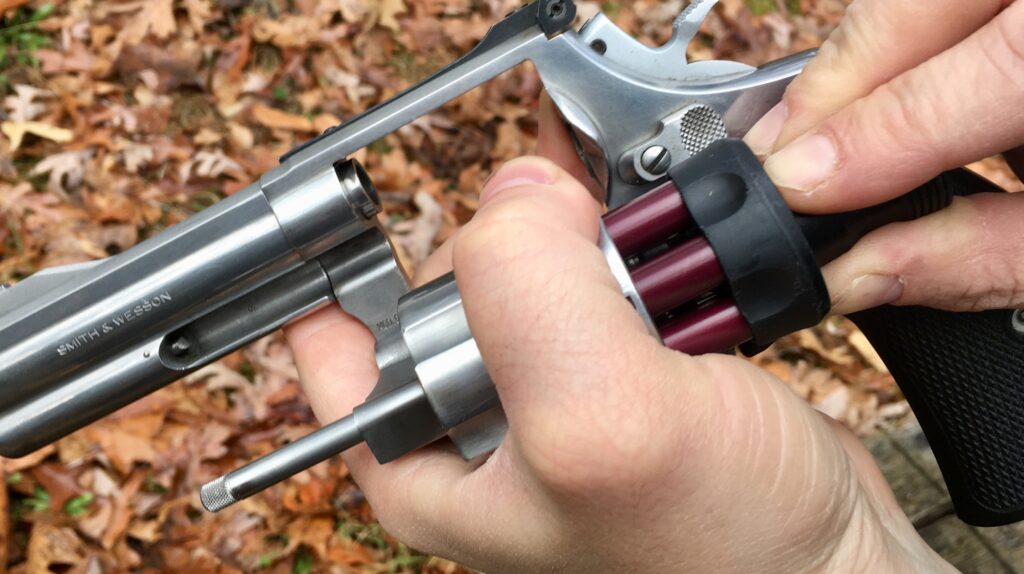
With the current ammunition shortage, it’s important to avoid unnecessary wear and tear on your duty ammunition. Constantly unloading and loading the premium defensive ammunition in your semi-automatic pistol is really bad for it, and can lead to major issues, such as bullet setback, damaged hollowpoints, or damaged case rims. Since it’s not as abusive to repeatedly load and unload revolver ammunition, most of my dry practice time is spent with revolvers. They’re just easier to set up for safe dry practice.
Primary Choices
For primary carry, and home or vehicle defense, I usually use a 7-shot Smith & Wesson L-Frame, or a 6-shot Smith & Wesson K-Frame, with a 2” to 3” barrel. Currently, a 3” ported S&W Performance Center Model 586 L-Comp 7-shot, a 2.5” S&W Performance Center Model 686 7-shot, or an older 2.5” S&W Model 19 are what I’ve been using the most.
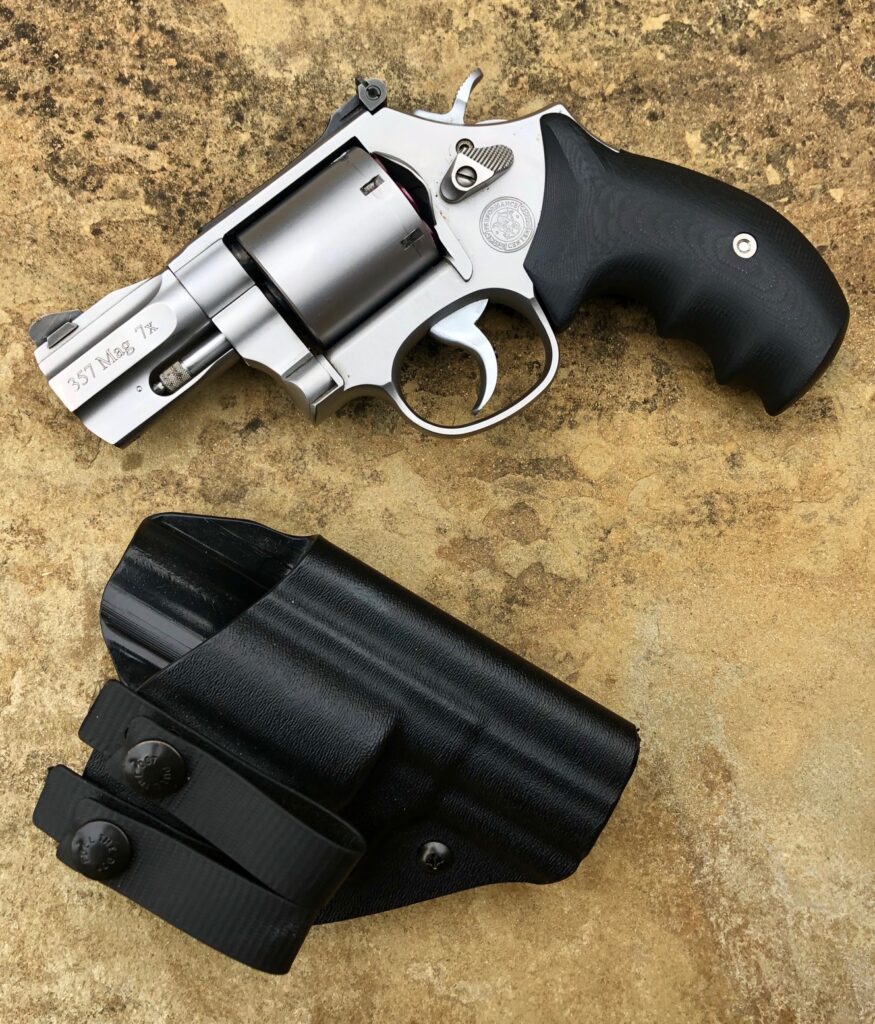
However, I have many different Medium or Medium-Large frame revolvers to choose from, and my choices change regularly, depending on my mood. There are a number of good sources for these kinds of guns, with Ruger, Colt, Kimber and others all making suitable guns in this category.
As much as I live with a modern 9mm polymer pistol daily (usually a Langdon Tactical Beretta PX4 Compact Carry), and a small lightweight snub revolver as a backup, I do love having access to a modern defensive revolver close by.
Practical Considerations
If I am carrying a revolver as a primary gun, I prefer a 6 or 7-shot gun for Inside the Waistband (IWB) carry. At times I will use a smaller, steel, 5-shot J-Frame, but do prefer the larger guns.
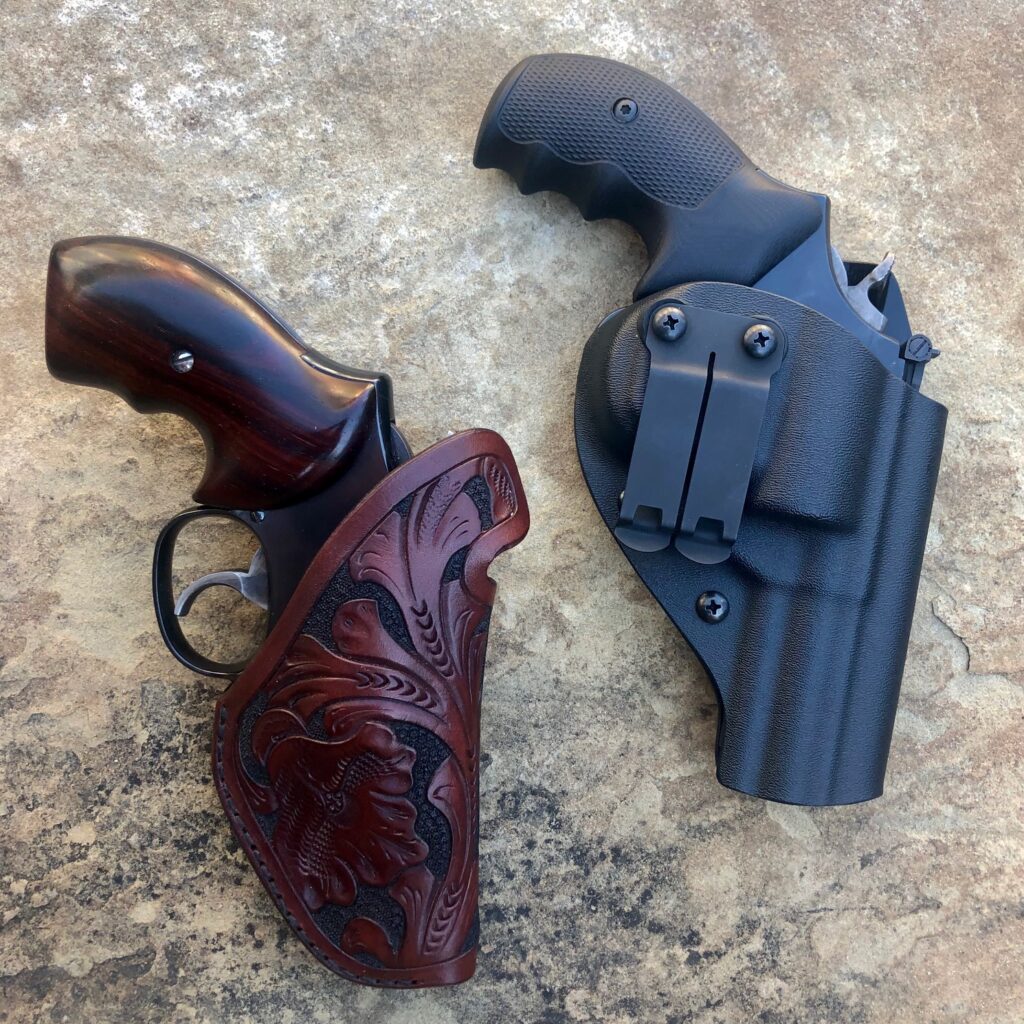
One area where I really like a revolver is when working inside a car. In my experience with actual shooting investigations, interior vehicle work is where we see a ton of semiautomatic pistol malfunctions and failures. Guns are often shot “in space” inside a car (floating and not in a locked firing position) and this type of shooting is where revolvers rule the roost, because they don’t need a firm support to operate reliably. They also work well for contact shots, or when you’re entangled with an opponent, whether in a car, or during a street or home assault.
Revolvers work well for those who are not extremely proficient with firearms, who can make tragic mistakes during unloading and clearing by simply getting the steps out of order. Their simplicity of operation is an added safety feature for these under or poorly-trained people.
“Thinking Triggers”
The long, double action triggers on revolvers really help with managing people at gunpoint, especially for folks who are not experienced at pointing guns at other people, or having a gun in their hand when dealing with threats. Under stress, people may reflexively start to pull the trigger when they’re surprised or startled, lose their balance, or get knocked around. The relatively long and heavy travel in a double action trigger is a good insurance against this, and makes it a bit more forgiving of human error. Human error and Murphy are very likely to show up in complex use of force problems, and it’s wise to carry a gun that helps to protect against these threats.
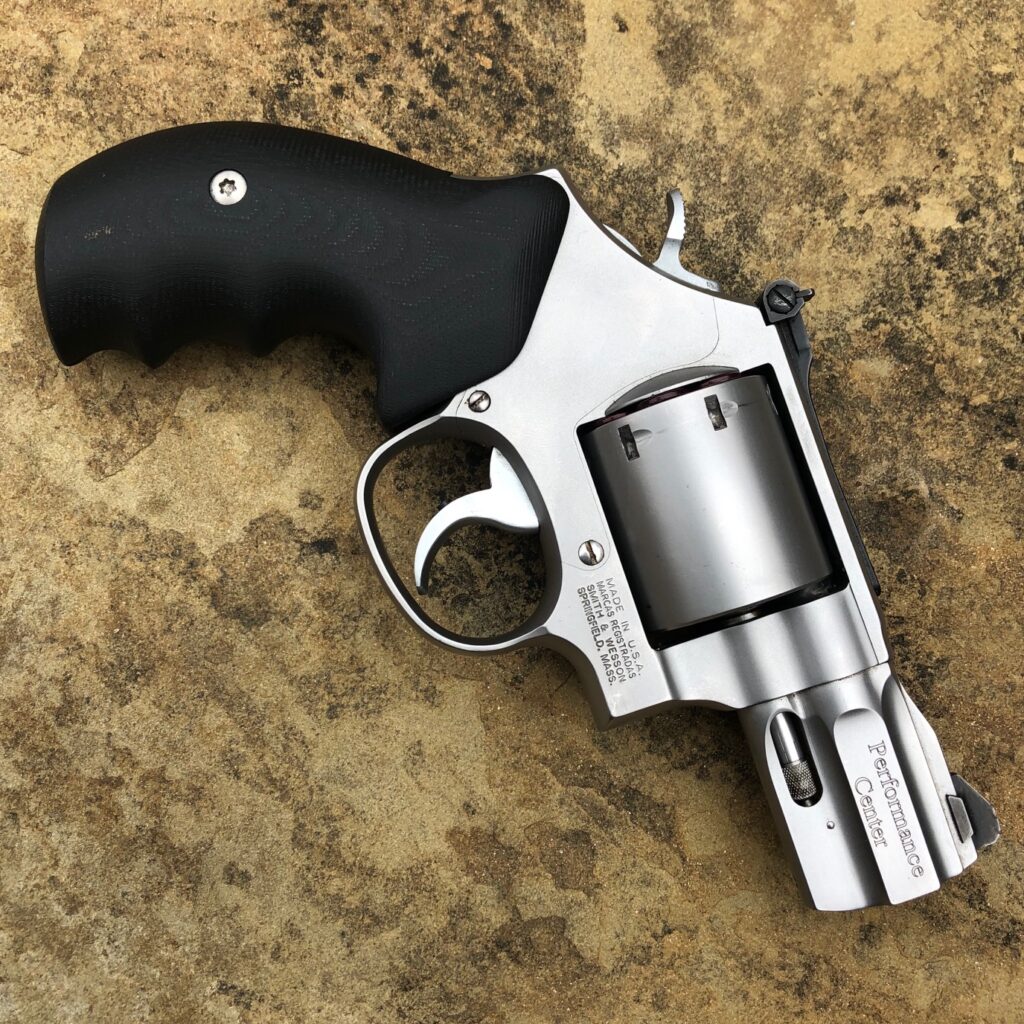
I also believe that double action, modern defensive revolvers lend themselves well to deliberate shooting, at what I term, “assessment speed”. Assessment speed is the speed at which you can receive and process information, then make good decisions, while shooting, and it’s slower than the fastest pace you can shoot at. Nobody seems to want to make social media and YouTube videos about shooting at true assessment speed, but this is the speed that will allow you to succeed in the field during a lethal force application. I tend to shoot my revolvers at very deliberate speeds. It was drilled into my head very early that you absolutely have to get everything done with the initial load in the cylinder, so accuracy and fire discipline were highly emphasized.
Political Considerations
The limited capacity of a revolver may also provide an unexpected advantage for some people, depending on where they live.
Sadly, many Americans live in states with magazine bans and a negative perception of guns. The citizens, district attorneys and law enforcement agencies in metropolitan areas and blue states may be hostile towards the ownership and use of semiautomatic firearms with normal capacity magazines, believing they fall outside of the scope of the Second Amendment. While I find that abhorrent, it’s a reality for a ton of people.
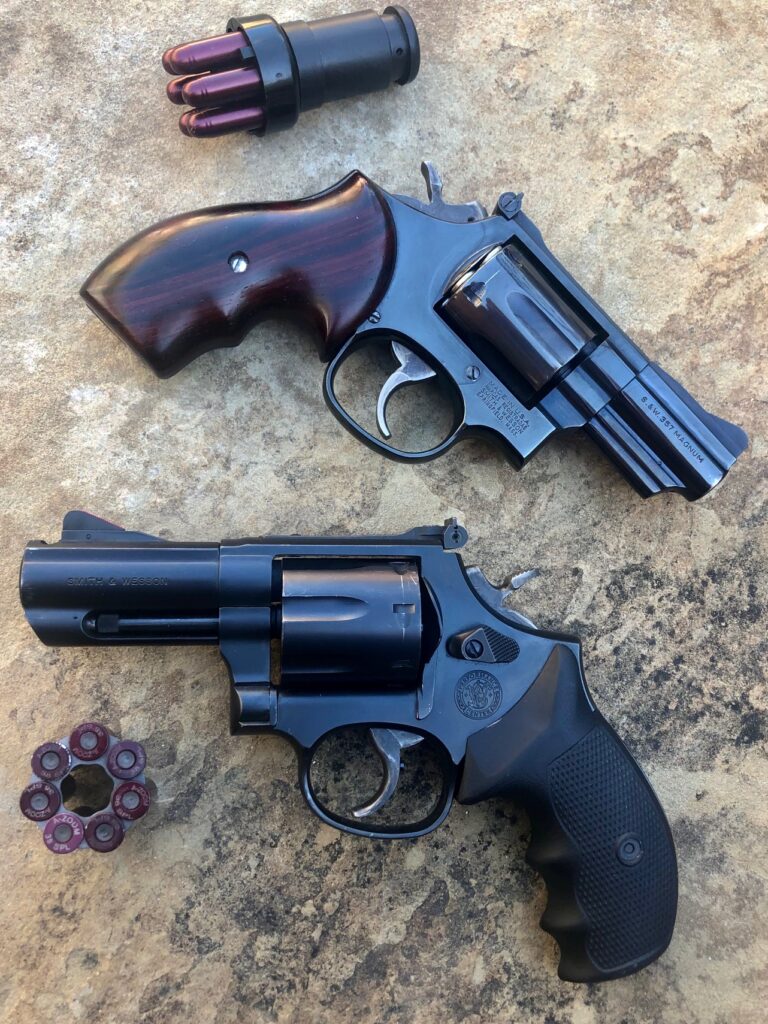
These anti-gun people may not object to the ownership and use of revolvers. It’s wrong, but it is reality in many places. In example, several years ago, I was supposed to go to New York on a security contract. To prepare for the trip, I bought an 8-shot, S&W Performance Center Model 627 snub and a Milt Sparks PMK holster for that detail, to avoid any issues with New York’s “SAFE Act,” and the other draconian state and city gun laws in that area. The revolver would have been legal, whereas most semiauto pistols with normal capacity magazines would not have been. I would not have felt under-gunned, even remotely, with an 8-shot .357 Magnum that I shot really well.
ICE: Break Glass
These guns also make really good home defense guns where they tend to sit for very long periods with no attention or maintenance. They excel in the “fire extinguisher” role for many people, and are easier for an untrained or under-trained family member to use in a crisis.
A classic example of the “fire extinguisher” gun is a never-fired, 3” Colt Detective Special, that I purchased new-in-the-box for my collection. It was originally purchased by a prominent member of the Dallas elite for his wife in 1965, after she was the victim of a criminal attack in their home. The gun was loaded and placed in a nightstand drawer in 1965, and sat there in that condition for the next 50 years. Despite the fact that it never received any maintenance, it was completely functional with no issues. For that lady that owned it, the revolver was a comfort, and she would have had a very good chance of being able to operate it, and have it work, if she had ever needed it–even with no training or shooting practice at all.
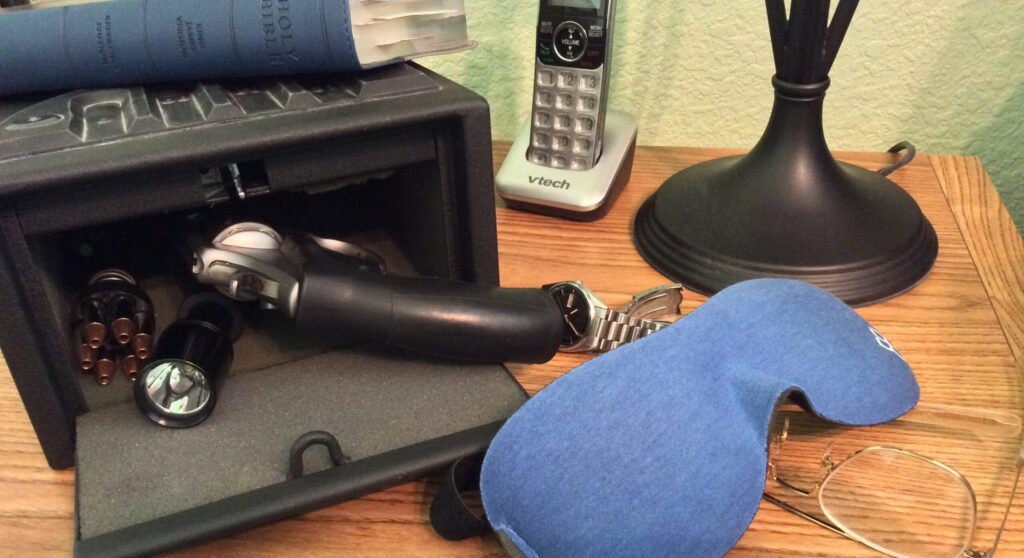
Would this be the type of person we would want grabbing a striker-fired pistol, with a short and light trigger, out of that drawer in a crisis? I doubt she would have been capable of safely checking the condition of a pistol like this. Sometimes a gun that is “really easy to shoot” is not necessarily a positive.
Total Package
For many folks, all of these factors are big advantages that may outweigh the revolver’s disadvantages in size-efficiency and capacity. The revolver may not carry as many rounds as a semiauto pistol for the same size and weight, but their simplicity, tactical reliability, “thinking triggers,” resistance to neglect, and cultural and political acceptance make them a useful alternative to consider for many shooters.
So, there is still a place for the modern, defensive revolver. If you shoot them a lot, they’ll require strict attention to cleaning and maintenance routines. However, if they remain unused, they literally need nothing.
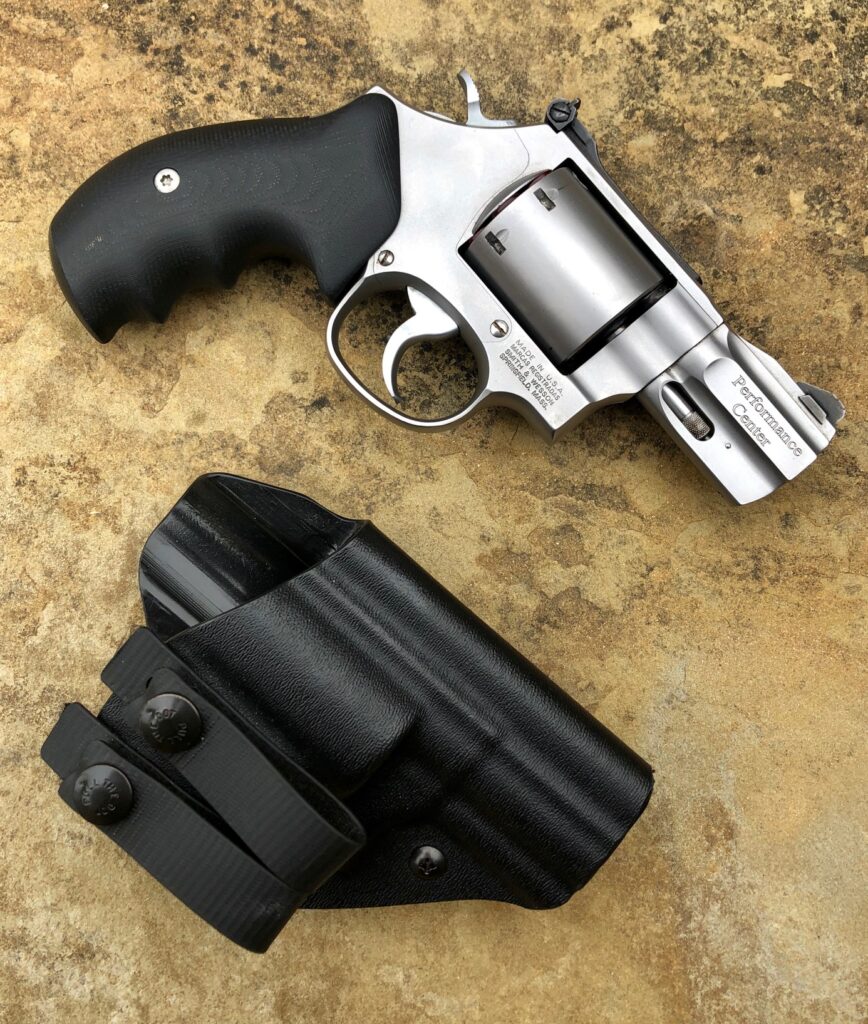
Looking ahead, I believe that politics and the erosion of Second Amendment rights will heighten interest in revolvers in the future. Personally, I do not like the least qualified people on the planet making my self-defense tool choices for me, but sadly, we live in a reality where that is fast-becoming the rule, rather than the exception. I hope we will be able to protect our Second Amendment rights and our freedom to select our own defensive tools, but if we’re forced into a revolver decision, I am prepared for it. I think it would be smart for others to prepare for this possibility, as well.
On a positive note, they’ll find that if they can master a revolver trigger, they will generally shoot everything well.
The modern defensive revolver might be considered a niche tool by some, but it solves a lot of problems, for a lot of people. I think it will be around for some time to come.

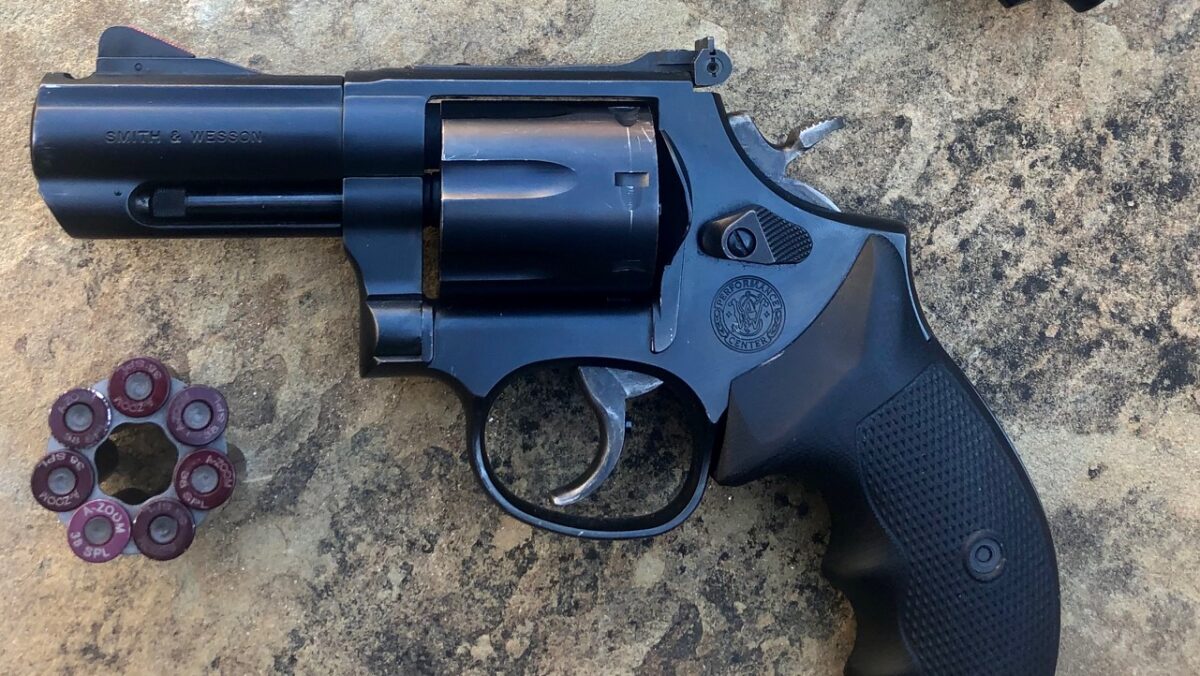
Nice piece, Darryl!
Thank you Mr. Bolke for the excellent read- lots of wisdom in a short article! You articulate your concept of “assessment speed” well, and it’s a huge check in the plus column for using revolvers defensively. Accuracy, fire discipline, and Murphy insurance. Amen! There is no statistic for the number of rounds that weren’t fired by folks in the middle of an adrenaline dump because of a long double action trigger pull. If there were, I think revolvers would be credited with saving legions of folks from undue misery on many levels. You make a strong case for the prudence in selecting a revolver for martial duties in contemporary times.
Mr. Bolke,
Thank you for a great overview on the advantages of a revolver. I very much appreciated you articulation of the concept of ‘assessment speed’. A semi-auto CAN be fired at assessment speed, a revolver almost forces one to do so.
Another good reason to carry a revolver is simply that one may shoot it better. I carried a revolver on duty for the first dozen or so years of my career, before switching to a ‘wonder nine’ in the mid-1980s. When I retired, I went back to a revolver.
Though this may certainly not be the case for everyone, I personally find that I can get a proper grip more reliably and can make an accurate first shot faster with a revolver than I can with a semi-auto. I believe that is much more important having a large number of rounds to make up for misses.
Thanks again for an excellent article (and for showing us some very nice revolvers, though I would have liked to have seen your 627, too).
RBO
We started in Law Enforcement at a time when it was absolutely drilled into your head from the beginning you had to get it done in the first six rounds and accuracy was emphasized of speed or high round counts. While I would not want to use a revolver as a primary today being sent to others people’s emergencies via 911, I think they are viable for a lot of folks for getting out of trouble being the only goal.
I know this is an old post, but I saw it and agree 100%. I have a law enforcement friend that shoots revolvers better than autos. He’s shoot’s his Ruger RedHawk better than his glock! I just a civilian, but I believe a revolver fills the bill for my needs. I’ve been shooting for years, but still are more comfortable with a good revolver. I’m no where nearly as experienced as someone like Daryl Bolke, but if a revolver is good enough for a guy like him, it’s good enough for me and my purposes of self defense. It appears that I might have been on the right track as far as personal self defense weapons for average Joes like me.
A lot of very well thought out, and salient, arguments in this post. The revolver has always excelled in the entangled fight space, IMO, and that is why so many peace officers still reach for a J frame S&W for a back up gun. Given that a significant percentage of encounters that private persons have are within arms reach, on face a good quality revolver has a strong case to make.
That the administrative actions and manual of arms are so much easier for un- and under trained shooters is something way, way too many “gun guys” and instructors lose sight of. My wife, who shoots annually, or so, at best is very comfortable, and very accurate, with her 2.5 inch Model 19 and in her case it ain’t broke so I am not going to go try to fix it.
Darryl,
I think that you are correct in all of your points. I have advocated and used R’s for the same reasons even with a long history (40+ years) and use of self-loaders on and off-duty.
The problem we are both now facing as septuagenarians is increased joint inflexibility (despite regular exercise including gel crush balls). The aging process is inexorable. Performing a smooth double-action trigger operation has become problematic for both of us.
I have read extensively regarding the S&W EZ line. Do you have any time behind that platform to suggest those a midway point between an R and a standard self-loader?
Welcome aboard Sir! We’re glad to have you and the rest of Darryl’s Facebook fans visit us here at RevolverGuy. We hope you’ll pull up a chair, make yourself comfortable, and stay for a while.
I’ve fired the M&P Shield EZ pistols in both .380 ACP and 9mm and think they could make life simpler for someone with strength issues in their hands. The slides are easier to work than the other Shield pistols, and the single action triggers have a relatively short and light travel. My favorite feature is actually the magazine loading button, which (like many .22 autos) allows you to compress the magazine spring and lower the follower for easier loading.
Alas, it’s not a free lunch. While the controls ease the burden, the grip safety does spoil the feel of the grip for some folks, and there’s a potential that someone with reduced grip strength or flexibility may not disengage it with reliability—that’s something you’d want to evaluate by finding a rental to shoot, if possible. It’s also possible to fumble the grip when you’re in a rush and grab the pistol in a way that the grip safety may not properly disengage—unlikely, but Murphy lurks around every corner.
Additionally, some models ship with a manual safety, and if that’s not part of your normal habit patterns already (probably not, unless you shoot 1911s regularly, in addition to your revolvers), it will take a substantial investment of time and effort to build those neural pathways, and make the habit stress-proof.
Be advised there is a recall active on these pistols, so if you purchase a used one, you’ll want to see if your specimen is affected before you shoot it.
Thanks again for visiting and reading!
Also worth a look is Walther’s CCP. It’s a gas retarded blow back design with a soft recoil spring. Get the second version. The first was difficult to field strip. Walther fixed that for the second version.
There is one other note, that should be added to this excellent
article. The defensive revolver works very well for people who have problems with their hands and wrists. After a 20 year Army career my hands due to injury no longer work as well as they should. My primary weapon in the Army (due to M.O.S.)was a pistol.I started with my favorite the M1911, then moved on to the M9 and M11. While I love all , the years have caught up with me. I now carry either a Colt King Cobra 3in or a Colt King Cobra Carry 2in. My backup, in a pocket holster, is a S&W Model 649. These revolvers work well and if necessary, I am able to use them even with my hands. I feel if I had to use a semi auto and my hands fail , I would be unable to use it effectively. The revolver , for me is the best defensive weapon.
I have severe arthritis in my hands. I tend to do well with revolvers these days because grip strength is not as critical with them for reliability. Hopefully, I can keep my trigger finger working enough to manage a double action trigger.
My wife was a decent revolver shot in our younger years and had to deploy one in an attempted pharmacy robbery when she was practicing before her stroke in 1999.
She has a RB 4” M10 available as her revolver and has enough hand strength left to cycle it six times if needed.
I occasionally carry Smith K frames as belt guns in lieu of the office issued Glock when off duty.
A 442 is a nearly constant pocket companion when off duty.
Welcome aboard, Darryl.
‘Assessment speed’ . . . The double action revolver perfectly combines the ability to quantify your assessment speed with precise trigger discipline. Dry firing also allows you to maintain the strength in your grip and trigger finger. Speed kills, but it can also get you killed. A slow hit always trumps a fast miss.
Aside from the physical benefits dry firing and live fire practice with the DAR, the complete interaction between shooter and revolver facilitates an ongoing mental programming update of feedback signals from the trigger to the brain, and from the brain back to the trigger via the index finger. Put it all together and it looks like Front Sight, Trigger Press, Follow-through.
Whether you carry 6 rounds or 16 rounds, if you can’t hit your target when the brown stuff hits the occilating wind turbine, no amount of bells and whistles will bail you out.
All of this boils down to a quote attributed to the late-great Bill Jordan: “Speed is fine, but accuracy is final.”
Aloha, do you have any concerns with gasses escaping and damaging the shooters fingers? Can you speak to this potential for injury?
Aloha Mike, glad to have you join us here. A proper grip will keep all your fingers clear of the barrel-cylinder gap, and eliminate any concerns. I’ve not had any injuries from letting fingers get too close to the gap, but I have had some stinging and soot when my long fingers accidentally got ahead of the cylinder face on a tiny J-frame. Not a big deal, but the consequences could be more severe with a higher pressure load (my incident was with .38 Special, which is low pressure—about half that of .357 Magnum).
I like to avoid a thumbs-forward grasp as a result, but my buddy Justin has a smaller hand and doesn’t have any difficulty using one. You may enjoy Justin’s article on this subject, here at RevolverGuy:
https://revolverguy.com/thumbs-forward-revolver-grasp/
I’ve fired my revolvers from a “retention” position, close to the body, many times, and have not encountered any issues with that. Again, this is with .38 Special. If you’re a fan of high pressure Magnums, this may be more of a concern.
Personally, I’m much more leery of barrel porting than I am the escaping gas from the B-C gap. I prefer not to have any ported barrels on my defensive guns, but reasonable people can differ about that. You’ll notice one of Darryl’s guns is a K-Comp, with ports.
Hope that helps. Thanks for reading.
This is a very good article. I’m an ORC (Old Revolver Cop) who carried a round gun for the first 20 years or so of a 30-plus-year career, and I like and trust them. The point made here about magazine-restricted jurisdictions is one I’ve made several times. I like the point the author made about shooting inside a car and the potential for malfunctions if you’re using an auto.
But one place the auto has it all over the revolver is weight. An L-frame like the one the author carries weighs about a pound more than a Glock 19, and even a short K-frame weighs about half a pound more. That makes a difference to those of us whose misspent youth made us achy, creaky, and chronic Ibuprofen customers today. I’d like to see S&W or Ruger expand their steel-and-polymer revolver technologies into a 6-round, K-frame sized revolver. Do it for the geezers!
Me too, Sir! A new Airweight K-Frame model sounds like a neat idea, particularly since the supply of Model 12s has dried up.
I do have several lightweight larger size revolvers that have gotten a ton of use. My 327 PC snub is carried quite a bit as a car gun. For a lot of years my Hamilton Bowen custom 296 has been used as a back up gun in uniform, carried extensively mountain biking and fishing in the back country, and I have a S&W 386 Night guard I absolutely love as a Fanny pack gun for neighborhood walks. The one gun I really wish that S&W would bring back is the 242 7 shot.
Hey, Boss;
Bill Jeans here. Not being a computer guy I did not know about this site and your esteemed presence thereon. Long time, no see.
Like many, I started my LE career with a revolver, K19 4″. As you know, I was infected with the 1911 bug and switched. I have one revolver that I would not feel bad about carrying for self-defense at all and it is the “Retirement Present” I bought myself when I left Clovis. It’s a S&W Mountain Revolver in .44 Mag. I have taken two wild boar with it but no criminals. With .44 Spcl. loads I would not have much grief with carrying this as a duty weapon. Sam Trevino did an action job on it and I have a couple speed loaders that I have worked on it with. Nothing wrong with a good wheel-gun, that’s for sure
Sir, we’re honored to have you stop by here at RevolverGuy. We hope you’ll look around and enjoy your stay.
That would make an excellent carry gun indeed. Ruger did just that with a small frame revolver in multiple calibers.
All good points, thank you for the article sir. I also like the fact that a revolver can handle a wide variety of power levels and bullet shapes, much more so than an auto loader. Gives more versatility and also is an advantage during ammo shortages when one’s load of choice may not be available.
Agreed Paul. On that note, you might enjoy our discussion of this in the previous post:
https://revolverguy.com/revolvers-and-ammo-shortages/
Welcome aboard!
Well written ! Agree on all . I have 4 revolvers in addition to my Semi’s ( .22 mag 8-shot{loud with low wall penetration danger} , .38 snub , .357 snub, .44 Spcl Snub ) . Mostly for night/home defense , b/c I sleep so much harder than I used to . Plus, simplicity when you are half-awake is another reason to not have a light trigger semi as your first reach weapon ( no matter how much you train when awake and alert ). Also , some of the same issues from “in car work” would rear it’s head shooting from bed , at night , in the dark , half-asleep ; or groggily walking to investigate why your dog is low growling ( though by that time, I would have a flashlight , or the shotgun equipped with one ).
RevolverGuy makes me feel “at home”!
About inside-the-vehichle shooting, another disadvantage of semi-automatic pistol is the hot ejected case, deflected by the windshield, that hits the firer´s face.
The “fire extinguihsher” philosophy is correct. Caxias do Sul, Brazil, 2012: a 86-year widow mistress killed a criminal in self-defense with a .32 Colt Police Positive from her deceased husband. The gun was loaded 50 years before!
Excuse me for the long text of news translation:
June 11th, 2012
86-year-old woman shoots a burglar who broke into her apartment
The house was on the second floor of a building in Caxias do Sul. The elderly woman, who has three daughters and five grandchildren, took the revolver from the wardrobe and killed the invader with three shots.
The 86-year-old woman, who prefers not to identify herself, does not forget the attempted robbery on Saturday night. The thug broke into a building in downtown Caxias do Sul and went to the second floor, where her apartment is.
The thief climbed the railing outside the apartment and broke into a window that gives access to the room. From there, he headed for the room where the elderly woman was sleeping.
“That guy came in through the door, opened like this. I looked, ‘but how did you get in here?’, Thinking it was my grandson. He didn’t move anything and went out the door and said ‘calm down’, he said to me. I looked at him and saw that he was not my grandson. I went near the wardrobe and had the revolver. He said ‘you old lady don’t know what, open that gate here’. ‘How am I going to open it? Wherever you entered, you will leave ’”, she says.
Although scared by the situation, the resident did not hesitate to use the gun. “I thought, ‘what do I do? It’s me or him ’. I thought of my daughters, my granddaughters and took it: ‘now you go’ and ‘bang’. He never imagined. I shot, took it close to the heart. Then he went, raised his arm, I said ‘he is alive’. I remembered his crimes, and said ‘now go another’ and ‘bang’ and ‘bang’ ”.
The housewife has difficulty walking and arthritis in her hands. She says she never shot before. The police seized the revolver, which is a family heirloom. “50 years ago it was there and I had never used it. I didn’t want to do that, but I was obliged ”.
The resident was indicted for intentional murder, when there is an intention to kill, but she must answer the inquiry in freedom. If the conclusion is that she acted in self-defense, the case will be closed.
The officer handling the case was surprised by the reaction, because of the age of the victim of the assault, but recalled that the policy of the police is never to react.
Erick, that’s quite a story! Thanks for sharing it with us. I hope this 86 year-old widow will obtain justice through the legal system. I’m glad she had that old revolver available to defend herself. Somehow, I think if the gun had been a Colt 1903 auto, which had been untouched for 50 years, she would not have been able to make it fire a second and third time.
Mike,
Yes, the old lady was acquitted, but, one year later, she died in a fire. She was a very religious person, and had the habit to light candles, that started the fire.
After the self-defense incident, the family reinforced doors and windows, that difficulted the firemen work.
Here in Brazil, we have some house security concepts totally opposed to US ideas. The predominant idea in my country is the “inverted prison”. Evacuation routes and emergency personnel access are often despised, because the fear of home invaders are much higher.
A tragic ending to the story, Erick, but definitely informative and a good warning. Thanks for the info.
Nice article Darryl! You make a lot of good points. Oh yeah, and your medium-large frame revolver collection is pretty impressive.
I have started working with my own Smith 686+ 3” seven shot for many of the reasons you discussed. I just have to get used to the heavy factory trigger and the carry weight.
I hope to see you grace the pages of the Revolverguy website in the future!
Welcome back.
I was a 1911 guy for over four decades after the Army. As you might guess age caught up.
Left shoulder was a major repair and the right shoulder was a salvage operation. Arthritis in the hands and left wrist.
S&W model 21 in 44 special and/or a model 642 in 38 special. I like the long trigger pull of 10 to 12 pounds. Deliberate shooting you nailed it.
Excellent, my everyday carry is a 5 shot 44SPC revolver and has been for many years. Although occasionally when I work certain details and assignments I supplement this weapon with others. But always, my start point and constant companion is my revolver and always has been. I laugh at these “Johnny come lately” know it alls with their “appendix carry” expert advice. We called it “gangster carry” among other terms, or just stuffed it in the pocket, which is another topic. Great article and knowledge for the youngsters 🙂
Will probably never happen but I wish Smith & Wesson would produce a Model 12 with a 3 inch heavy barrel and round but.
Absolutely Mark! I think that would be a really neat and efficient option.
its so refreshing to hear such a thoughtful and well reasoned argument for revolvers. They certainly aren’t the ‘tacti-cool’ thing these days, but – for all the reasons you mention- I think they are the better option for MANY individuals who have been convinced by ‘experts’ that the semiauto is the ONLY reasonable option.
You’ll find plenty of that here, Ryan. Poke around in the archives and I think you’ll find a lot to enjoy. If you missed this one, it might be a good place to start:
https://revolverguy.com/is-the-snubby-enough-gun/
I’ve been reading revolverguy for se time now and have been really enjoying it. I have noticed that the authors keep referring to sneaky Murphy. Could someone explain that to me?
Glad to hear from you, Zane! That’s a reference to “Murphy’s Law,” which states, “anything that can go wrong, will go wrong.” It’s long been part of military tradition to characterize “Murphy” as some hidden villain, lurking in the shadows, waiting to cast doom on your efforts when you least expect it. If things are going well, then they take a sudden turn for the worse, it’s because “Murphy” visited you. He likes to show up at the very worst time, and ruin the show.
Now you’re read into the secret, and can enjoy it with the rest of us! Thanks for writing in.
I think a few modern snub noses would be pretty cool: 2.5 or 3″, Air Weight (not the scandium Air Lite) and with the adjustable sights (so you can put a EGW mounting plate and a red dot on it)
6 shot K Frame 38+P
7 shot K Frame 327 (is this possible?)
7 shot L Frame 38+P
8 shot L Frame 327 (is this possible?)
AirWeight keeps them lighter to compete with semi-auto weight, decent capacity when compared to some of the micro semi-autos and some way to be optic capable is a nice option. You could save almost a full pound off the weight of the the current K frame guns.
I think you’re definitely onto something here, Keith. However, I think the K-Frame is a little small to stuff 7 rounds of .327 Fed Mag into the cylinder. You could definitely do that on an L-Frame, though. Likewise, the L-Frame is too small for 8 rounds of .327 Fed Mag, but you could do it on an N-Frame.
By comparison, Ruger has a 7-shot GP100 (dimensionally comparable to an L-Frame) in .327 Fed Mag, and an 8-shot Redhawk (dimensionally comparable to an N-Frame) in .357 Mag.
Don’t forget, the .327 Fed Mag is a VERY high pressure cartridge, at 45,000 psi MAP. This far exceeds the 35,000 psi MAP of the larger .357 Magnum. You can see why you’d need a good amount of steel in the chamber walls, and couldn’t squeeze too many of them into a cylinder.
Yeah, I wasn’t sure if it was possible or not. I know there are 6 shot SP101s and I think there was briefly a 6 shot J frame so I thought “maybe.” But the N frame starts to get pretty big. And if you can’t go up a round in capacity on the same size frame, I’m not sure the .327 adds much value. In that case I would just stick with the more readily available and cheaper .38 +P.
I still not tried the .327 Federal, but looks interesting. Its ballistics is the same of the good old .30 Mauser.
A long, heavy, double action trigger is still not a substitute for keeping your finger off the trigger until you are ready to shoot. Years ago, Omaha, Nebraska police carried S&W Model 10s. One officer stumbled in the middle of a foot pursuit and shot himself in the leg. Whether revolver or semiauto, if pulling the trigger will cause the gun to fire, keep your finger along the frame and outside the trigger guard.
Still can’t convince my boys to come over to the other side. Thanks for the validation, Mr. Bolke!
Almost three years ago, I suffered a knee dislocation during a foot pursuit. I dropped in the ground while pointing my Interarms Walther PPK .380 Auto ready to fire. Its heavy trigger avoided a tragedy.
I don’t knew, at that moment, if the criminal was armed. If was, he could fire at me in tenths of second. So, I was with my index finger on the heavy DA trigger when I feel something like a lightning hitting my right knee.
It’s true that is better to follow the safety rules, and Walther PPK has a heavier DA than most revolvers. But worked for me.
If you are gonna carry a wheelgun.. carry two. Reloads under practical conditions while being shot at (or clubbed) is a very trying experience.
Now I have a passle of six shooters… but I pack Glocks. Still if I was to pack round guns it would be something like a Speed Six 2 3/4 inch .357 backed by a .38 spl. airweight S&W Centennial.
And if endowed with lots of money… 2 1/2 S&W 66-1 .357 Magnum backed by same Centennial.
And I say this folks having packed legaly for well over 20 years. And yes I’ve packed Speed Six, Centennial, 66-1 Combat Magnum, S&W 64 2″, and even once.. just once, S&W 629-2 Mountain Revolver in .44 Magnum.
But nowdays.. Glock 26 or 43 or when I wanna hike, Glock 29sf.
Paul, thanks for sharing your thoughts.
It seems like your principal focus is capacity, and a revolver is certainly never going to win that fight. However, I’m less convinced that capacity (and its corollary, the emergency reload under fire) is as important as most people make it out to be.
If your yardstick is capacity, then the contest is rigged against the revolver from the start. It’s kind of like comparing a Ford F-150 to a Ford Mustang, and asking which is better for moving a few yards of gravel? The answer is obvious, but if I change the game and ask which is better for street racing, then we start to appreciate their respective strengths and weaknesses.
A revolver offers capabilities that a small auto does not, and does certain jobs much better. This is why they continue to thrive in an era of increasingly capable autopistol designs.
There’s plenty of room for both, which is why I carry both Glocks and snubbies. I’ve been carrying for decades myself, and don’t feel poorly armed with either a revolver or an auto. If asked to choose between the two, my answer would be “yes.”
I support the notion of carrying two guns, but I’m more driven by reliability and access concerns than capacity concerns.
Thanks for reading.
I usually carry two guns religiously when away from home. Usually a semi auto pistol and a lightweight snub. If I am carrying a revolver as a primary, I also carry a snub. It is both an accessibility thing and a back up for an emergency or failure of the primary as well as a hand off gun if needed.
In the days when I primarily carried a revolver as a police officer I carried three. My duty gun, an ankle gun, and another behind my speed loaders in case I didn’t have time to reload the primary in a fight. While the modern service pistol is incredibly size efficient for capacity and weight compared to a service size revolver, I consider the lightweight snub to be equally size efficient for ease of carry in non traditional locations in deep concealment along with power and reliability in its size. This is all about simple matching tools to YOUR needs and abilities rather than tools other people think you should use based on their needs and perceived abilities.
I have a snubnosed Model 12. I’d love to see it brought back someday, with a 3 or 4 inch barrel. I think it’s pretty much ideal for a lightweight “fighting” revolver. All the benefits of the Model 10 (my favorite revolver), but easier to pack around.
I like the S&W 69 as a modern defensive revolver as well. If ammo were easier to come by, I’d like to try some different .44 Magnum loads to see if there’s a load that could be viable for self-defense. As it is now, I think .44 Special is the best option for it if you’re not dealing with animals.
Axel, the world would be a wonderful place with a lightweight framed 3” k frame size gun.
A few months ago I bought my wife a Smith and Wesson 380EZ. She was concerned about weapon manipulation, so we thought this was the perfect pistol. Except, it’s not reliable in her hands. The muzzle blast scares the crap out of her and jerking her hands back interferes with the pistol cycling. Sure training would take care of this, but with the ammo shortage and her not wanting to train, she is now carrying my 442.
Thanks for writing, Brandon. As you know, the blast won’t be any better with the 442, and the recoil will probably be more significant, depending on the load (I’d suggest some target wadcutters), but at least the operation will be simpler. You can do lots of inexpensive dry practice with that 442, which will go a long ways towards making her more comfortable with the gun.
Your testimony proves several of Darryl’s points.
When the market gets back to something that looks reasonable again, you’ll have more ability to shop for a better choice, but it sounds like the 442 will do a good job in the meantime. Best of luck and be safe.
Darryl-great article as evidenced by the fact that we’re still talking about days later! I too started on the job with a revolver, Ruger Security Six and own mostly revolvers even now. I do routinely carry a S&W 3953 but I usually back it up with a S&W 649 Bodyguard and still replace the 3953 with my retirement gift to me, a Ruger GP100 3”.
I have just read this article for the third or fourth time. It gets better every time I read it. Revolvers are great weapons. They require little maintenance and minimal training to be effective. They’re probably the safest gun you can find. The little old lady with the revolver in her night stand is closer to the norm than most believe. When a new shooter asks what gun I’d recommend for them, it’s usually a revolver.
Great article Darryl. Keep them coming.